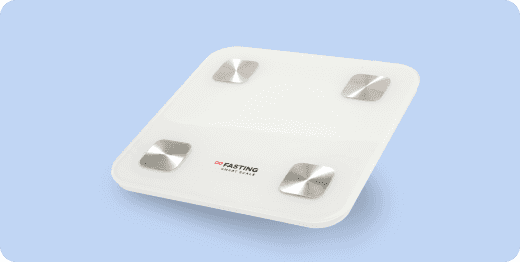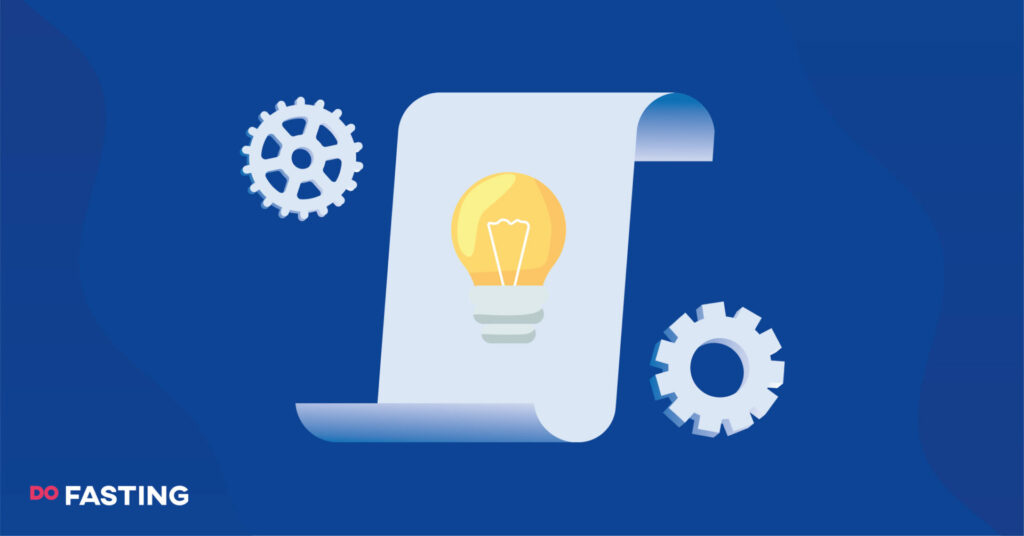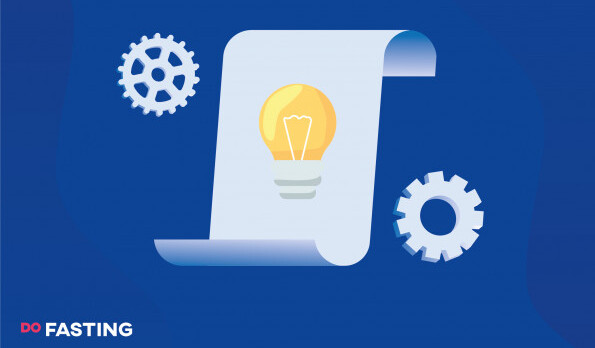Contents
What Is Intermittent Fasting?
Intermittent fasting (IF) is when you cycle between eating and fasting. It’s mostly considered an eating pattern rather than a diet. This is because it doesn’t strictly prohibit what to eat but focuses on the times you are eating.
Intermittent fasting accelerates weight loss and leads to various health benefits, such as reduced inflammation, regulated blood sugar and cholesterol levels, improved brain health and many others.
Let’s take a moment to go over the basics of an intermittent fasting plan and how it can help to achieve weight loss, ease certain health conditions and provide a better, healthier lifestyle.
The basic principle of an intermittent fasting schedule involves fasting and eating windows, in different time increments depending on the plan and what sort of results you’re looking to get.
During the fasting period, you practice continuous calorie restriction, without eating carbs, protein, or sugar. And during the eating window, you are allowed to revert to normal eating of a healthy diet.
The ability to alternate between an eating window and a fasting window allows you to eat fewer calories and encourage fat loss through something called a “metabolic switch”, in which your metabolism is able to switch into ketosis. We’ll go into the process of ketosis more in-depth in just a moment.
But it’s through these time-restricted eating patterns that your body can process and burn fat easier, lose weight, and repair itself on a molecular level for a variety of intermittent fasting health benefits.
Take a
1-minute quiz
and discover how much weight you can lose with DoFasting!
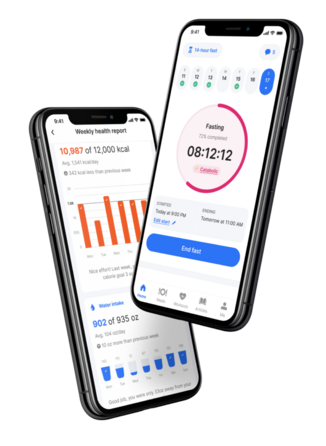
How Does Intermittent Fasting Work?
The short answer is by restricting calories and achieving the state of ketosis.
As previously mentioned, fasting and eating patterns naturally restrict calories and moderate your overall macros, particularly when it comes to carbohydrates and sugar.
This is especially important because of the way the human body processes carbs and sugar into glucose stores that raise your blood sugar levels.
While glucose itself is not necessarily a bad thing for everyone, excessive amounts of glucose in your system will not burn efficiently as fuel and will accumulate into fat as time goes on.
And if you simply continue to eat the same high-carb, high-sugar, and high-calorie diet, even while exercising, it can be exceptionally hard for your metabolism to catch up to the amount of glucose in the body, and you might not see any weight loss results.
When practicing intermittent fasting, scientific evidence has shown that by reducing your calorie intake significantly for an extended period of time, your metabolism is pushed into ketosis— in as little as 12 hours, in fact!
Ketosis is a fat-burning system when the body is deprived of new glucose levels from carbs and sugar, and thus must turn to using body fat for fuel instead of relying on blood sugar levels.
Ketones are created from fatty acids in the liver, and will start producing results during fasting days.
And not only does this allow your glucose levels to safely decrease, which is good for blood pressure and helps to prevent type 2 diabetes, but you also begin to experience permanent fat loss.
This is where intermittent fasting results are most apparent— instead of simply losing water weight, you can target fat within the body for both weight loss and weight management!
Losing Weight With Intermittent Fasting
Intermittent fasting is one of the better methods to safely lose weight and keep it off, instead of following a crash diet that might damage your metabolism over time.
By burning the fat stores instead of glucose in the body, you can target the typical “problem areas” that many overweight people identify as fat stores, including the stomach, hips, thighs, and others.
And in addition to enhancing your metabolic health and ability to lose weight, there is a myriad of other health benefits of intermittent fasting that you can look forward to.
Of course, weight loss can ease pressure on your joints, help lower blood pressure, and increase your capacity for physical activity, which are all great benefits.
But the ketosis and stages of fasting that occur during intermittent fasting schedules go beyond just the number on a scale and how efficiently you can lose weight.
Prolonged fasting, especially, has many benefits that include lower risk of chronic diseases, better heart health, and can even help regulate the menstrual cycle for women.
The key to using intermittent fasting days and non-fasting days is regularity— you should select a fasting schedule and stick to it.
However, that is not to say you cannot increase or decrease the length of fasting periods should you need to, and we actually recommend not jumping into the hardest method right away. Instead, working up to your fasting period goals is a better option for success.
But it is essential to do your best not to break the fast while inside the window. This will halt ketosis, fat burning, and the weight loss process in its tracks and push you right back to the start. So, that’s why we recommend starting small and increasing fasting periods slowly, to help you be more successful.
Take a
1-minute quiz
and discover how much weight you can lose with DoFasting!

All Intermittent Fasting Plans Covered
Types of intermittent fasting depend on how many hours of the day you want to fast versus eat, and so are typically broken into two portions that equal 24 hours. However, some prolonged fasting plans can even extend up to 3 days.
As such, let’s go through the various methods of intermittent fasting written as timed schedules and discuss some of the benefits associated with each.
14:10
As with most intermittent fasting types, the numbers are the ratio of hours. This method involves fasting for 14 hours and then a 10-hour eating window.
Starting out, 14:10 is an accessible eating pattern for many people new to intermittent fasting schedules. It can also be done multiple times per week, between two and three times in a seven-day period.
Because you will likely be sleeping for the majority of the 14 hours if you start after dinner and use an overnight fasting method, many beginners find this plan great to start out at. For example, starting your fast at 7 p.m. the night before and ending it at 9 a.m. the next morning!
There are many benefits to this fasting method, as well. Scientific evidence shows significant weight loss in patients who pursued the 14:10 hour plan, as well as lower blood pressure and better insulin responses within the metabolism.
12:12
Another very popular type of intermittent fasting for beginners to lose weight, fasting for half the day leads to plenty of health benefits. As previously mentioned, ketosis can occur after the first 10 to 12 hours of fasting, so this is the minimum you can expect weight loss from.
This method can also be safely done two or three times per week, but as always, beginners should ease into the schedule one day at a time.
Apart from weight loss, fasting for 12 hours also lets your body get to the stage of autophagy. This is a fantastic benefit that actually gives your entire system time to rejuvenate and detox, repairing itself on a cellular level.
16:8
When eating for 8 hours and fasting for the remaining 16, you are certainly getting into the more serious intermittent fasting plans and the results will reflect that.
This method puts your body in a prolonged state of ketosis for maximum fat burning and weight loss, but also has many associated advantages. For example, your HGH or human growth hormone levels begin to rise, helping to battle hunger hormones and to regulate your circadian rhythm for better sleep.
The 16:8 method is typically recommended about twice a week and needs to be built up to. But many practitioners report fantastic results and more energy than ever!
18:6
When you narrow your calorie intake to a 6-hour eating window and offset it with an 18-hour fast, the results are more pronounced than ever. The 18:6 method works for many people, but you need to figure out your schedule in advance of beginning this type of fast.
You typically only get two meals within 6-hour eating periods, so determining the importance of breakfast over dinner is essential.
For example, if you can skip breakfast, you can start fasting after your evening meal the night before, and fast until around noon. Alternatively, if you need to eat breakfast and can skip meals in the evening, eat around 9 a.m., have lunch at 1 p.m., and grab a healthy snack before 3 p.m. when fasting starts.
Benefits of this kind of extended ketosis include stress resistance and decreased disease risks, among others.
5:2 (The Fast Diet)
As one of the most popular methods for beginners, the 5:2 or Fast Diet involves 5 days of normal eating and 2 non-consecutive days where you eat much fewer calories, sticking below 500-600 calories for the entire day.
It is essentially a type of easy alternate-day fasting, but simplicity doesn’t mean there are no results. Because this diet is very flexible according to your schedule, it can easily be worked into every week for consistent calorie restriction and weight loss.
And while it might not be as effective as prolonged fasting for ketosis, you can still expect some results, and this can be a great option for anyone who has a busy week but still wants to fast.
In particular, the 5:2 method is good for heart health and preventing cardiovascular disease over the long term, by boosting cardiometabolic processes.
20:4 (Warrior Diet)
Touted as one of the original ways that the human body was meant to feed and conserve itself for optimal energy, the 20:4 method or Warrior Diet involves fasting for 20-hours before a 4-hour eating window for maximum effectiveness.
However, we recommend that you stick to a balanced diet during the 4-hour eating pattern of the Warrior Diet to keep the results amplified.
That includes healthy fats, lean protein, whole grains, and plenty of liquids to keep blood sugar levels fairly low. This can be a healthy lunch, dinner, or breakfast, but only one meal is recommended during the Warrior Diet’s eating period.
This method should only be done once a week to begin, and if you want to pursue it more, make sure to listen to your body and not push yourself. Benefits associated with this diet plan include blood sugar control and low blood pressure.
23:1 (OMAD)
Eating just one meal a day sounds daunting, but this type of intermittent fasting is very effective and safe. The 23:1 or One Meal A Day diet is particularly useful as it keeps your body in ketosis for an extended period of time, allowing for maximum fat burning.
Practicing this method once a week can give users some great results, but more frequent OMAD fasting can lead to headaches and fatigue, and so is not recommended.
The benefits of intermittent fasting for 23 hours include increased weight loss rates, a significant decrease in insulin levels, and better glucose oxidation out of the body.
24-Hour Fast
Essentially one step up from the OMAD method, 24-hour intermittent fasting weight loss is supercharged, along with the other health benefits. This is the point where fasters can start seeing the effects of prolonged fasting windows as they progress from the 24-hour mark.
But because the process of going without food for an entire day is quite strenuous on the body, we recommend practicing it once a month, supplemented with easier fasting cycles in surrounding weeks.
Because you are putting your body into such an extended state of ketosis, your cells have more time to detox, gut enzymes to regulate, fat stores to burn away, and glucose to safely be metabolized and leave the body.
36-Hour Fast
As we begin discussing the long-term fasting periods, it’s important to keep in mind that these methods should only be used around once or twice a month, and need to be worked up to— including 36-hour fasts.
But in terms of health benefits, putting your body into ketosis for essentially a full day (given that it takes 10-12 hours for that stage) is fantastic. Not only does your insulin sensitivity plummet and the immune system has time to heal, but the risk of heart disease is also greatly decreased by lowered blood pressure and cholesterol.
48-Hour Fast
Going without food for 48 hours is another type of extended intermittent fasting. While it might sound difficult to achieve, the effects are undeniably excellent.
Studies prove that brain health and mental cognition are increased, and even your mood can lift when fasting for 48 hours, thanks to bettering the autonomic function throughout the entire body.
72-Hour Fast
The three-day or is one of the longest options for intermittent fasting periods, and should only be done by experienced fasters.
However, at this point of fasting, your body is able to fully regenerate the immune system, including IGR-1 and PKA levels in the body, which can be elusive outside of this window. In addition, people often report reduced feelings of hunger and higher energy levels throughout.
Alternate-Day Fasting (ADF)
As the name suggests, the eating pattern for an alternate-day fasting plan includes cycling between days of normal eating with a healthy diet and days where you restrict calories. This turns into one full day of fasting, followed by a day of feeding, etc.
Alternate-day fasting can produce some great results but is also strenuous on the body, so should be exercised carefully. But the results speak for themselves— studies show drastic reductions in body mass index and weight for ADF participants, as well as lower blood pressure.
Water Fasting
As the name might suggest, this form of intermittent fasting entails a water-only experience. And though there’s no set time limit for how long you should water fast, it’s generally not recommended for a period of over three days or 72 hours.
Some of the greatest benefits of water fasting include weight loss, weight management, and increased periods of autophagy— or, as one study puts it, essentially rebooting your body.
The Dubrow Diet
Created by reality television’s Dr. Dubrow, this form of intermittent fasting works on the concept that the less you eat, the healthier you feel in the long run. It involves eating a low-carb and whole food-based diet with strict meal timing and portion control.
Overall, the Dubrow Diet has many benefits, including anti-aging effects, a flexible plan, and some delicious meals.
Leangains
This diet is incredibly similar to the 16:8 method, because it uses 8 hours of the day in which to fuel your body. However, where the Leangains diet differs is in physical activity levels.
Leangains encourages resistance training to be mixed in with strictly structured eating, in order to enhance the fat-burning potential of your body even further. Weight training is essential to losing fat while building muscle, which leads to better cardiorespiratory fitness.
Take a
1-minute quiz
and discover how much weight you can lose with DoFasting!

6 Health Benefits of Intermittent Fasting
As previously mentioned, there are many health benefits of intermittent fasting, even beyond the obvious one of weight loss.
And those who choose to pursue an intermittent fasting lifestyle find their overall well-being greatly improved, thanks to the following intermittent fasting benefits.
1. Slows Down the Aging Process
Intermittent fasting might not be the fountain of youth, but it’s a close second.
Studies have shown that the mitochondria in your cells decline with age, but when patients fasted for extended periods, these molecules were able to promote better cellular circulation to decrease the effects of aging on the body and increase your lifespan.
2. Reduces the Risk of Diabetes and Heart Disease
We have mentioned the favorable effect of intermittent fasting on heart health, but this method is truly one of the best ways to reduce the risk of heart disease. Not only does intermittent fasting lower blood pressure and cholesterol, but it decreases stress in the body.
Additionally, with improved insulin sensitivity due to a fasting and eating pattern and low blood sugar levels due to reduced carbohydrate and sugar intake, diabetics and pre-diabetics can even reverse their insulin problems.
3. Benefits Your Skin
Not only can intermittent fasting help clear up various skin conditions tied to hormonal imbalances like acne by leveling out chemical secretions within the body, but it has also shown promising signs for skin cancer, inflammatory skin issues, and other dermatopathology conditions.
4. Improves Resistance to Oxidative Stress
It should come as no surprise that stress is bad for you, and levels of oxidative stress that can compound inside the body are no different.
During oxidative stress, there are imbalanced proportions of various hormones, free radicals, and antioxidants within your system, the body can start producing even more to try and solve the problem. However, this leads to a variety of inflammatory issues that can be chronic.
However, intermittent fasting actually helps to lower these internal stress levels by leveling hormone secretion and preventing the body from essentially combatting itself. This is done through reestablishing balance via autophagy in fasting.
5. Reduces Inflammation
Inflammation is the cause of many chronic diseases and health conditions when it gets out of control, including arthritis, cancer, diabetes, and can even cause blindness.
However, stopping inflammation and reversing the damage before it’s too late is entirely possible with intermittent fasting.
Studies show that fasting is able to prevent inflamed cells from circulating throughout the body, as well as boost the immune system’s response to further inflammation.
6. Improves Your Brain Health
Because of the cellular rejuvenation that intermittent fasting allows for, your body is able to preserve itself much easier and purge toxins and waste from the entire system— including the brain.
Fasting is actually shown to have positive effects not only on mental health but also on cognitive ability and the risk or progression of degenerative neurological diseases.
What Can You Drink During Intermittent Fasting?
While wondering what to eat during intermittent fasting might seem pointless, as fasting periods essentially revolve around calorie restriction, discussing the various things you can drink while fasting to keep yourself hydrated is important.
When you skip meals and avoid solid foods for several days a week, you will certainly feel hungry. But it’s worth it for the metabolic switch that changes your entire body into a fat-burning machine during fasting periods!
One of the best ways to help fight the hunger pangs is by staying hydrated and tricking your body into thinking it’s full. That includes plain water, black tea, black coffee, and bone broth for a “clean” fasting diet, as all of these drinks are too low in calories to break a fast.
Supplements and Medication
Many people have questions about fasting and taking medication, vitamins, and supplements. Can you still take pills while fasting? The short answer is, yes— maintaining a medication or supplement regimen will not affect your fast drastically.
However, because some pills and fat-soluble vitamins should be taken with a meal, you might need to work your fasting schedule around any rigorous medication routine. But for the most part, as long as you speak to a medical healthcare professional about any supplements or prescriptions beforehand, working them into intermittent fasting should be unproblematic.
Who Should Not Fast?
However, some groups of people should not try intermittent fasting without the advice or supervision of a healthcare professional due to some of the risk factors. Those who should not try an intermittent fasting program include if you are dealing with any of the following:
- Current eating disorders or a history of eating disorders.
- Breastfeeding or pregnant.
- Diabetics.
- Insomniacs.
- Pre-existing health conditions.
- Taking certain prescription medications.
- Those at high risk of cardiac problems.
- Under the age of 18.
Can You Work Out While Fasting?
In general, yes, you can work out and exercise during fasting periods. However, there are some considerations for any great physical activity while in a caloric deficit that you need to keep in mind.
The key is to schedule your workouts around the fasting and feeding windows of your chosen plan. For example, stick to low-intensity workouts while you are fasting so as not to deplete energy stores and overstrain yourself.
Leave the high-intensity workouts for any non-fasting days a week when you can eat a normal, healthy diet to sustain such levels of activity.
Will Fasting Lead To Muscle Loss?
For many fasters, worries about muscle loss are concerning. But studies have shown that drastic muscle loss even during long-term fasting is not a side effect. Instead, the primary loss of lean tissue and muscle occurs from shedding water weight and any detoxing that can happen within the muscle tissue itself.
If you keep your protein intake and healthy fats high outside of fasting days, and supplement with physical activity during those times, maintaining muscle mass and even growing it is definitely possible.
Intermittent Fasting Success Stories
If you want to be inspired by intermittent fasting before and after stories, this is the place. Here, we talked to some of the users of our intermittent fasting app to get their experiences.
Read on for the full scoop on their success stories and the ways to do intermittent fasting that worked for them, including how the DoFasting app helped achieve it.
Sandra
For Sandra’s intermittent fasting journey, she had to try several plans before finding the one that fit her lifestyle and helped her achieve her goals.
And by using the fasting window timers in the mobile app, as well as the array of exercises offered there, the 16:8 method was simple and effective— she’s 32 pounds down!
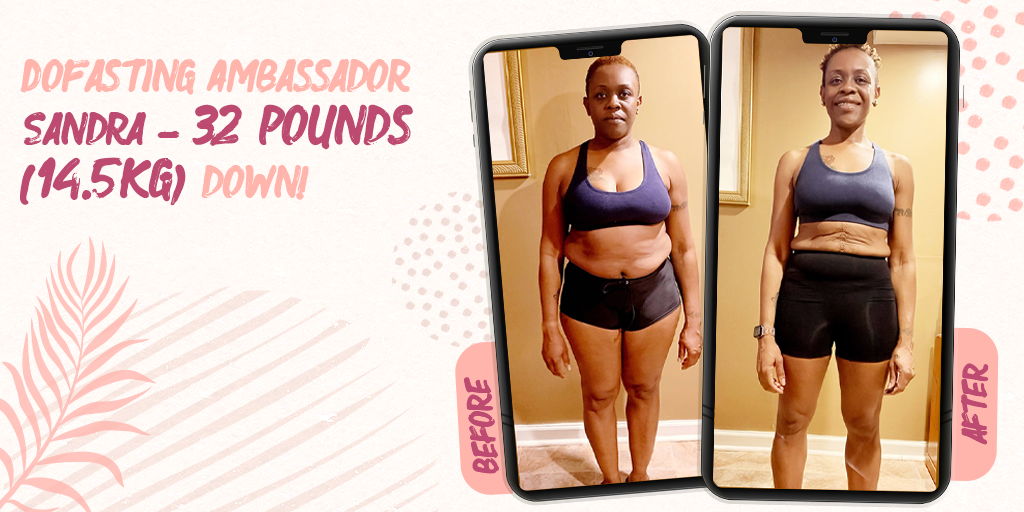
Dezarae
Food was always a comfort for Dezarae, but intermittent fasting helped her break that cycle and adopt a much happier lifestyle. Using the DoFasting app kept Dezarae inspired to smash her weight loss and she has since hit her goals.

Annie
After 5 weeks and 21 pounds lost, Annie was a firm believer in intermittent fasting. She found that logging her water intake with the DoFasting intermittent fasting app really helped keep her on track, as well as managing hunger pangs with DoFasting supplements.
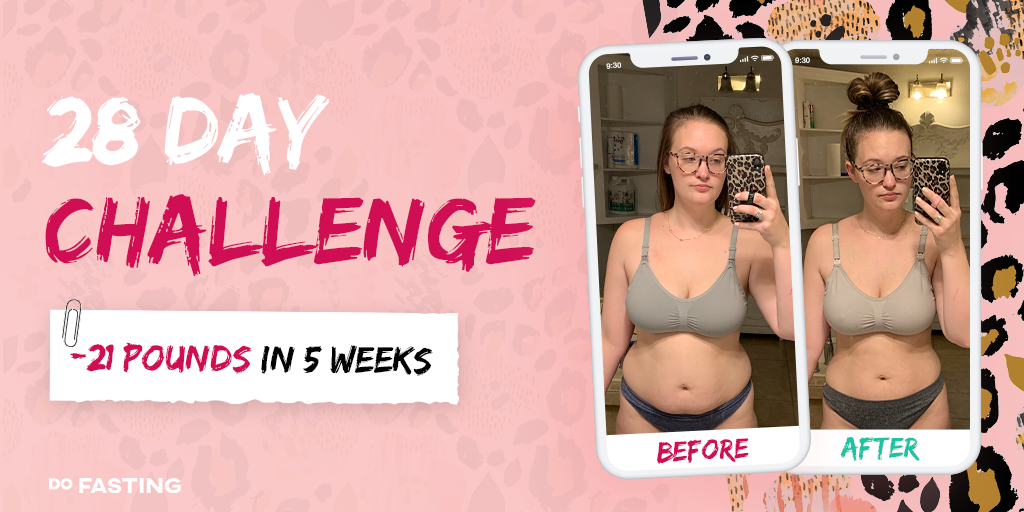
Conclusion
As we have discovered, even for complete beginners the process of intermittent fasting is great not only for the weight loss advantages it provides but also for the various health and wellbeing benefits.
Men and women fast to shed pounds, of course, but lowering the risk of heart disease, diabetes, and increasing your longevity are certainly not side effects to take for granted!
And with the wide range of ways to do intermittent fasting, there is a method that can be tailored to how many days a week you want to restrict calories. From half a day to three days, you can choose the best method for you and see the results for yourself. So, which intermittent fasting plan are you going to try first?
See how DoFasting will improve your life
Find out what works for you with this 60-sec quiz approved by our experts and get your personal revolutionary fasting assistant.
Start the Quiz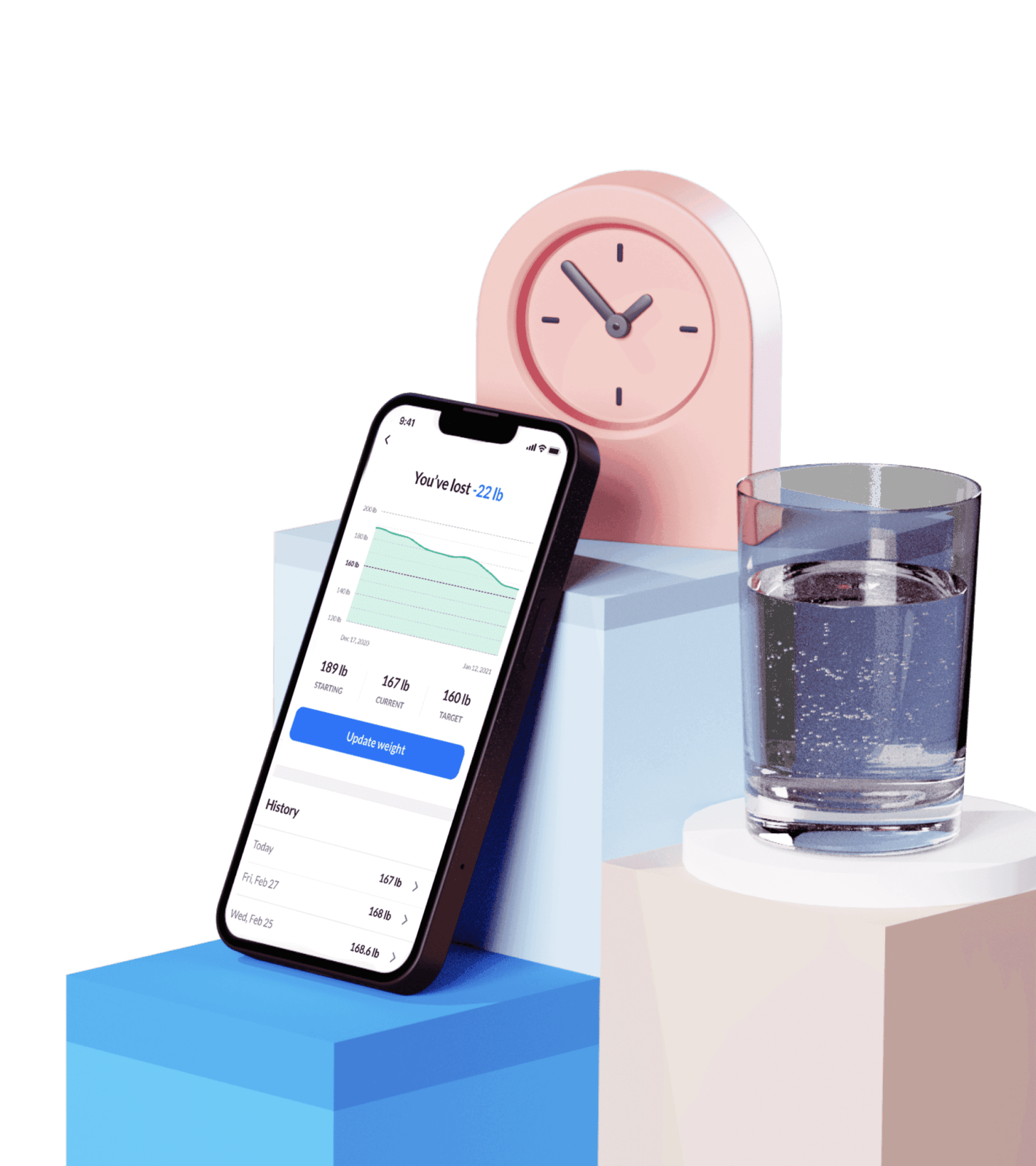
This is an evidence-based article that includes scientific citations. DoFasting’s professional writers and editors prepared the content, which a team of medical experts verified to be accurate.

